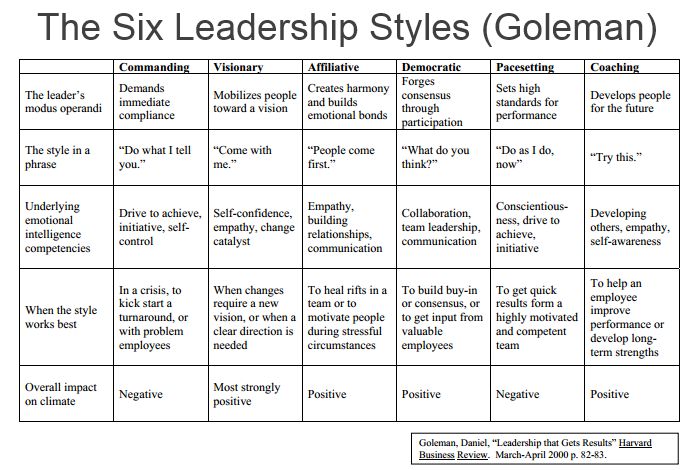Leadership Style and the Creation Company
Episode #6 of the course “Creating creation companies” by Barry Mapp
The wrong leadership style in business stifles creativity. Daniel Goleman has described six leadership styles, some of which would have a very negative effect in a creation company (see table below), and some of which would have a neutral or positive effect. (I actually don’t agree with some of Goleman’s assertions because, for example, he states that a commanding style of leadership works best in a crisis or with problem employees, whereas in my experience, a coaching style works best and doesn’t lead to “fire-fights” or crises in the first place. So-called “problem employees” always respond better to a coaching rather than a telling style.
Because one of the best leadership styles is a coaching style, let’s briefly talk a bit more about this and have a look at some differences between coaching and other forms of interaction intended to help people learn, develop, or transform.
Coaching is a particularly valid form of intervention for transformation in times of rapid change. Other modalities such as teaching, training, and mentoring are less useful, but they nevertheless still have a place in specific circumstances. However, telling and directing are not useful interventions when you want your staff to show initiative, be creative, be responsive and responsible, and be solution-focused.
Teaching, training, and mentoring are all based on the idea that the expert has all the knowledge required to solve the problems. Such a view might have been valid in the early part of the 20th century when things changed relatively slowly (and where you might have the same job for life, for example). However, in times of rapid change, the expert is less likely to have seen the problem before and is therefore less likely to have the best solution. Also, when staff are encouraged to come up with solutions for themselves, this is very powerful and motivating—and this is what the coaching model sets out to achieve. So what makes for a good coach?
An effective leader-as-coach is:
• Able to ask open, stretching questions in a non-directive, non-judgmental way and avoid using direct “why” questions (instead reframing them as “what” or “how.” “Why” questions make people defensive)
• A confidante, guide, facilitator, catalyst, and outside viewpoint—one that does not seek to judge and is always non-attached to any of the life issues involved in the client’s challenges
• Able to encourage, and when genuine progress has been made, to recognize and celebrate achievement
• A person who has learned to actively listen and is able to hold up a mirror to the client
• Able to keep the big picture in view as well as the details and helps others not to get bogged down in the details and instead focus more on the wider view (mind mapping is a very useful technique for helping with this)
• A person who “lives the talk” and exemplifies the behaviors they wish to see the company follow—work-life balance, personal development, continual improvement and learning, and working on limiting beliefs, etc. So the effective leader should demonstrate the behaviors that s/he wants to see in others.
Recommended book
“Coaching for Performance: GROWing Human Potential and Purpose” by John Whitmore
Share with friends


